Japan is probably one of the most industrial nations in the world today. It is a small country. However, the development that it has shown over the years has been very good. Japan became particularly prominent in world politics with its relation with World War II. So, it supported Nazi Germany. However, during world war II, the US chose to destroy it because the Japanese fought against them. We have all read about the horrors of Hiroshima and Nagasaki in our history and literature books. However, Japan developed really well in the ensuing years. This is how Japan is now, but how was it before any of these? In this article, we will see how ancient Japan was.
So, people all over the world watch anime and read manga. Ghibli movies have even won Academy awards in the US. We have seen some of the best directors like Akira Kurosawa come from Japan. Moreover, amazing writers like Haruki Murakami and the Nobel laureate Kazuo Ishiguro are also Japanese. So, Japanese culture is extremely popular. However, this distinct style of Japanese culture has its roots in ancient Japan. These are the roots that make Japan so special. Moreover, these are the roots that fight with the tides of western culture.
Ancient Japan Map
So, the map of ancient Japan was not very different from the current map. This is because of the remote location of the country. There were vast seas, oceans, rugged terrain, volcanic mountains, and steep rivers covering it. Therefore, Asian migrants have not invaded ancient Japan. So, the basis of their civilization is a foreign policy. This foreign policy stands in isolation. Between 1641 and 1853, there was very little foreign trade. This was again because the Tokugawa Shogunate enforced the Sakoku policy. It happened during the Edo period. The Sakoku policy said no to almost every kind of foreign trade. Outsiders have never been able to colonize Japan in ancient times. The Mongols failed to invade Japan twice.
However, the formation of ancient Japan is hard to know. In the Paleolithic age, there was a land bridge. So, this bridge connected Japan with the Asian mainland. Now, this was in 20,000 BCE. The bridge was at the height of the Last Glacial Maximum. However, this land bridge got lost during the Jomon period. This was because the water levels started rising around 10,000 BCE. Ancient Japan has maintained a policy of isolation and expansion. So, this is because of the insular map of Japan. Along the Eastern coast of the Pacific, it forms a stratovolcanic archipelago. It covers an area of 3,000 km. Hence, there are in total 6,852 islands. However, the main islands are five. These are Hokkaido, Honshu, Kyushu, Shikoku, and Okinawa.
Read Also: Polar and Nonpolar Covalent Bonds: Characteristics & Differences
However, people in ancient Japan had different names for their country. Nihon and Nippon are still very popular names. However, in ancient times, the predominant name was “Yamato”. In fact, before the coinage of the word “Nihon”, there were Chinese names. So, the Chinese used to call Japan “Wa” or “Wakoku”.

Ancient Japan Anime
Anime is a pretty new concept. So, locating anime in Ancient Japan might be nearly impossible. This is quite obvious as anime is a mode of animation. We all know that the world has seen animation only in the last century. One cannot call 20th century Japan to be ancient Japan. However, Namakura Gatana is the oldest existing anime. It is a short film. It came out in 1917. Most archives believed that they had completely lost the film. However, something amazing happened. It suddenly appeared in 2008. Three works started the concept of Japanese anime. The only one to exist in a proper condition is the Dull sword.

However, the manga existed in ancient Japan. Manga is just the book version of what we see in anime. They are like comics. However, the manga itself is a genre in literature. So, Japan gifted this to the world. There are scrolls of manga that even belong to the twelfth century. It is one of the greatest pride of ancient Japan. This is because the Manga runs from left to right on a page. It brought the way we read or write today. The manga of ancient Japan and the modern Western comics together shaped the modern manga.
However, if you are looking for anime that show ancient Japan, there are many. There are many anime whose setting is feudal Japan. So, they generally take place during the Heian and Meiji eras. As a result, these anime mostly focus on travel, village life, and warfare practices. One finds wide influences of Samurai, Shinsengumi, or the shogunate in such anime. Various anime are useful to know about ancient Japan. They tell a lot about Japanese history and socio-political systems. An example of anime showing ancient Japan is Hakuouki.
Ancient Japan technology inventions
We know Japan is home to some of the greatest technological inventions. So, from the rice cooker to the QR code Japan has greatly blessed the world. Japan developed the world’s first TV watch back in the 20th century. Moreover, we all know the unique feature of all modern-day technology inventions of Japan. They come with a speed that we cannot imagine like bullet trains. We find such fast trains in no other country in the world. As a result, Japan has already come with the 5G network. So, Japan has much to do with our networks too.
Hence, as one can imagine, ancient Japan must be technologically advanced. However, there is not much archaeological evidence to prove this. Still, Japan had given the world the unique architecture of their Shinto religion. This is a special architectural pattern. The importance lies mainly in the idea that it is very different from the Catholic or Islamic styles. Some of the oldest pottery existed in Japan. So, their science of storage must be very good. The largest wooden buildings in the world existed in Japan. Therefore, the civil engineering of Japan must be well developed.
However, ancient Japan was extremely good in the chemical and medical sciences too. In 1658, Mino Tarōzaemon discovered agar. Ephedrine was a traditional Chinese machine. It was very common during the Han dynasty. However, it was used in the crude form. It was again a Japanese organic chemist who chemically synthesized ephedrine. Nagai Nagayoshi did this in 1885. In 1804, Hanaoka Seishu conducted general anesthesia in surgery for the first time. The 19th century is not ancient Japan, not recent times as well. Moreover, one can imagine that traces of such developments existed in the Japanese cultures and practices.
Ancient Japan had the first hand-fan too!
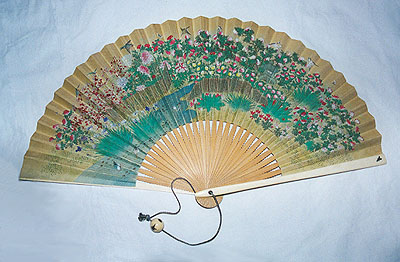
Ancient Japan History
So, the history of ancient Japan is quite long. Moreover, there have been various feuds and dynasties. As a result, it has seen the rise and fall of them. Hence, each of the powers has brought a different era. The culture and history of every era were quite different from others. So, we might be confused if we look at the overall history. Hence, we have a timeline here. This would help us to go through the different eras of ancient Japan.
Ancient Japan timeline
Jomon Period- 10,000 to 300 BCE
So, it was during this time that the neolithic culture came to ancient Japan. Historians think that it came from eastern and south-eastern parts of Asia. Therefore, the Sea of Japan acted as a passage. There were two main features of this period. So, people started to hunt and to gather food. However, the term “Jomon” comes from the term “cord-marked”. This, therefore, hints at the making of earthenware. During this time, settlements had started scattering all over the islands. However, they had still not attained an ethinic unity. All of them were quite different in their practices.
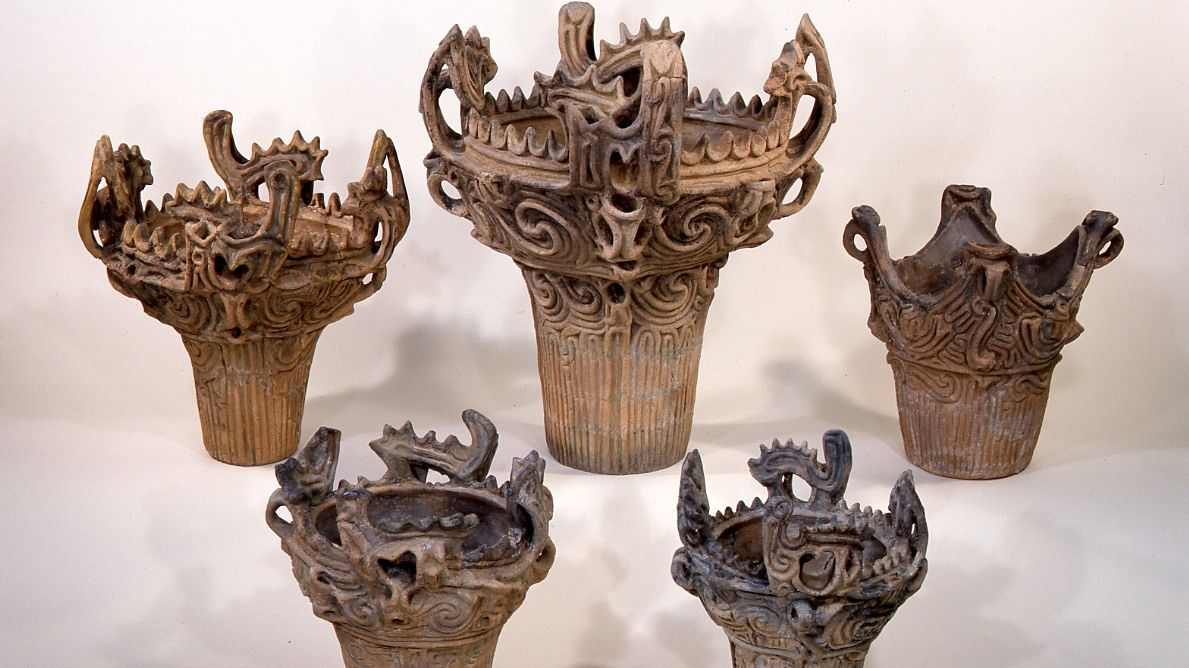
Yayoi Period- 300 BCE to 250 BCE
So, this period marks a break from the neolithic culture of the Jomon period. People from China and Korea brought in new cultures now. However, these new cultural practices might have originated from the Jomon culture itself. Undoubtedly, there might have been influences from the Asian mainland. However, certain historians believe that it was a complete removal. They believed the Jomon practices stopped operating. Japan is famous for the best agricultural practices of paddy. So, it was during this period when the settlers started producing wet rice. They advanced pottery and the usage of iron and bronze.
Moreover, society now has become more complex. So, for the first time in ancient Japan, we found proper villages. These villages had class systems. Moreover, the storage of grain led to wealth. However, there was still no central authority. Therefore, the political power of ancient Japan continued to operate at the village level.

Yamato Period- 250 BCE to 710 AD
So, this was one of the most important periods in the history of ancient Japan. There were two eras in it. These were the Kofun era and the Asuka era. Kofun lasted from 250 BCE to 538 AD. Asuka lasted from 538 AD to 710 AD. For the first time, ancient Japan saw the rise of a central power. This central power operated from western Japan, around the Yamato province. There was a local tribe here. So, they were the Yamato. Hence, they consolidated themselves and established power. They were the ones to claim imperial lineages. These would govern ancient Japan. Yamato widely followed the native religion Shinto. Therefore, Shinto mythological practices became very popular.
The Asuka era became very important because of Asian inputs. So, for the first time in ancient Japan, Buddhism and Chinese writings arrived. The Korean kingdom of Baekje played a major role here. Due to these Chinese philosophies, Confucianism and Chinese laws came in. Hence, they found a place in the new Japanese Laws. Considering these, Prince Shotoku made the Seventeen Article Constitution. Moreover, he also undertook the Taika reforms and the ritsuryo system.

Nara Period- 710 AD to 784 AD
So, the name Nara period itself came from the establishment at Nara. This was now the royal icapital of ancient Japan. Moreover, this is where the classical history of Japan begins. Imperial power started growing too much. Therefore, the dogma of imperial succession from the Sun goddess began. Moreover, this period marks the establishment of two important schools of thought in ancient Japan. These were Buddhism, Tendai, and Shingon. However, Buddhism at large became very powerful. Emperor Kemmu tried to free the empire from Buddhist supremacy. Therefore, he tried to shift the capital to Kyoto. So, this ended the Nara period.

Heian Period- 794 AD to 1185 AD
This was probably the most culturally rich phase in ancient Japan. Therefore, this period saw the greatest of the court’s high culture. Moreover, this age saw the birth of the samurai or the bushi class. This would later go on to become one of Japan’s most special features. So, it was their rise which ultimately ended the gilded age of Japan. In the Genpei War, the Tair and the Minamoto clans fought against each other. On the other hand, this period has seen some of the best artistic efforts of ancient Japan. The waka poetry and the Chinese style of ink painting, hence, became very popular.
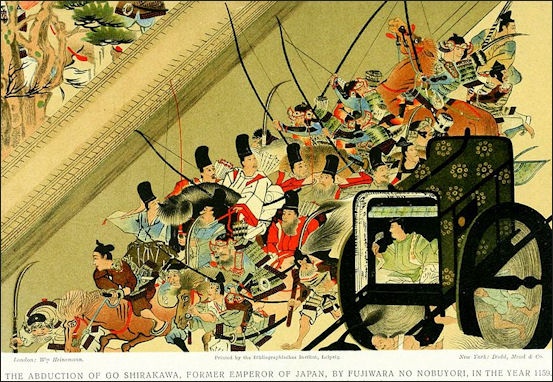
Kamakura Period- 1185 AD to 1333 AD
This period came when the Minamoto clan defeated the Taira clan in the Genpei war. Hence, feudal rule in ancient Japan began. The imperial structure continued to exist but only in name. This feudalism continued for 700 years. Hence, there were several internal battles. Moreover, this was when the Mongols under Kublai Khan tried invading Japan.
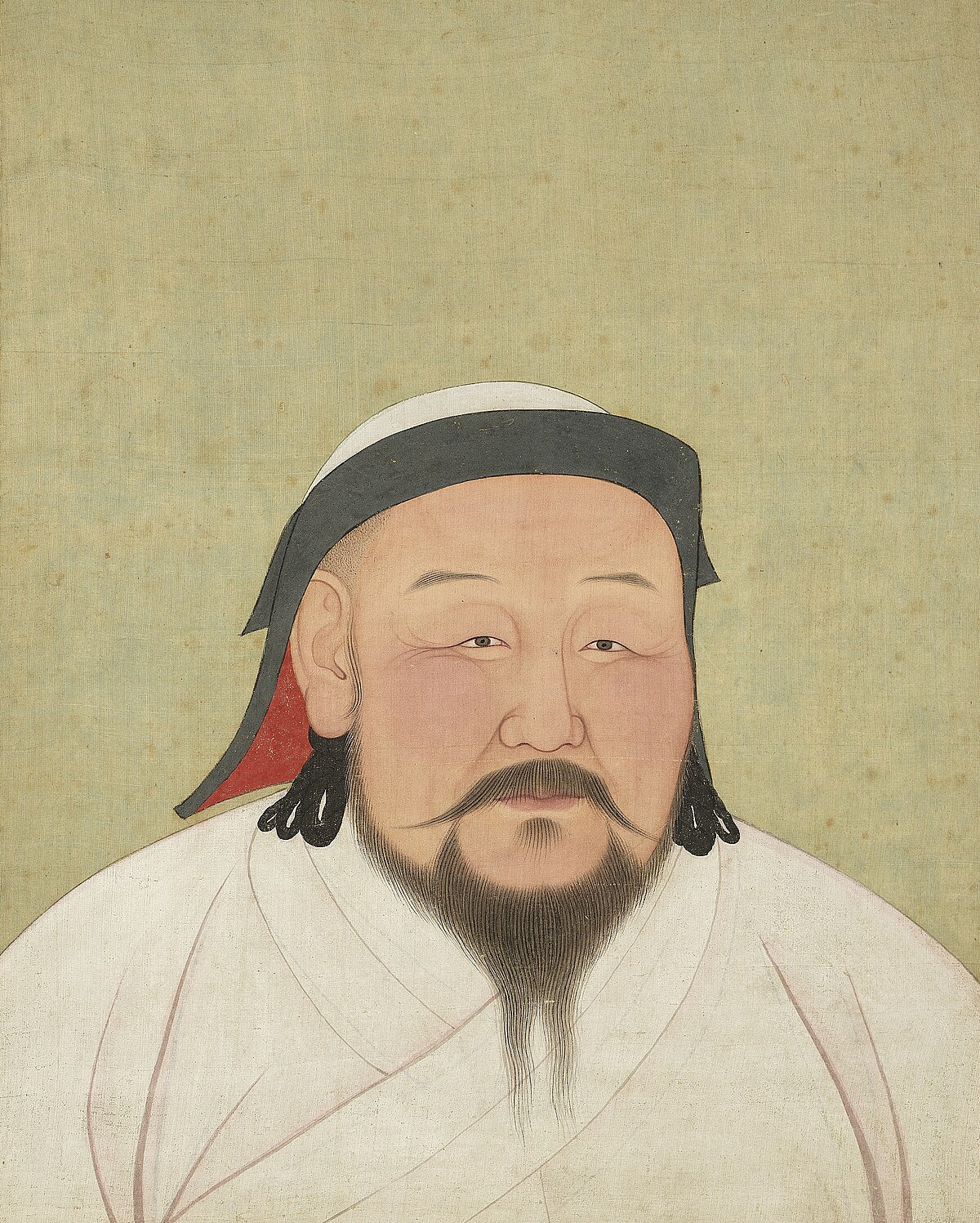
Ancient Japanese paintings
The Japanese paintings come from ancient Japan. Hence, from the Jomon and Yayoi periods, one finds different patterns. These might be related to plants, architecture or just shapes. While during the Jomon period, the artworks were on pottery, during the Yayoi period, they were on bronze bells. Moreover, during the Asuka period, Japanese art found major foreign influences. So, Buddhism arrived in ancient Japan during this time. As a result, the Chinese art and writing system became very popular. Hence, local artists of ancient Japan made cheap copies of the original Chinese artworks. From the 16th century, there were Western influences too. So, Japanese art is not only old but also contains a huge collection of styles and types.

Ancient Japanese clothing
So, Japanese clothing has a long history. We have already seen that the history of ancient Japan is divided into several eras. Now, each of these eras had its own set of cultures. As a result, there was a wide range of clothing practices across each era. The traditional dress of Japan is called wafuku. So, it includes the national dress which is Kimono. One finds very little information about clothing till the Yayoi period. During the Kofun period, there used to be cylindrical sleeves. Moreover, both men and women wore wrapping skirts (Mo) over trousers called hakama. However, gradually there would be other parts too. Women of ancient Japan would wear dresses with over vests and overskirts. They would also use stoles and waist sashes. Men would wear the Kamari hat, carry swords, and use beautiful sashes.
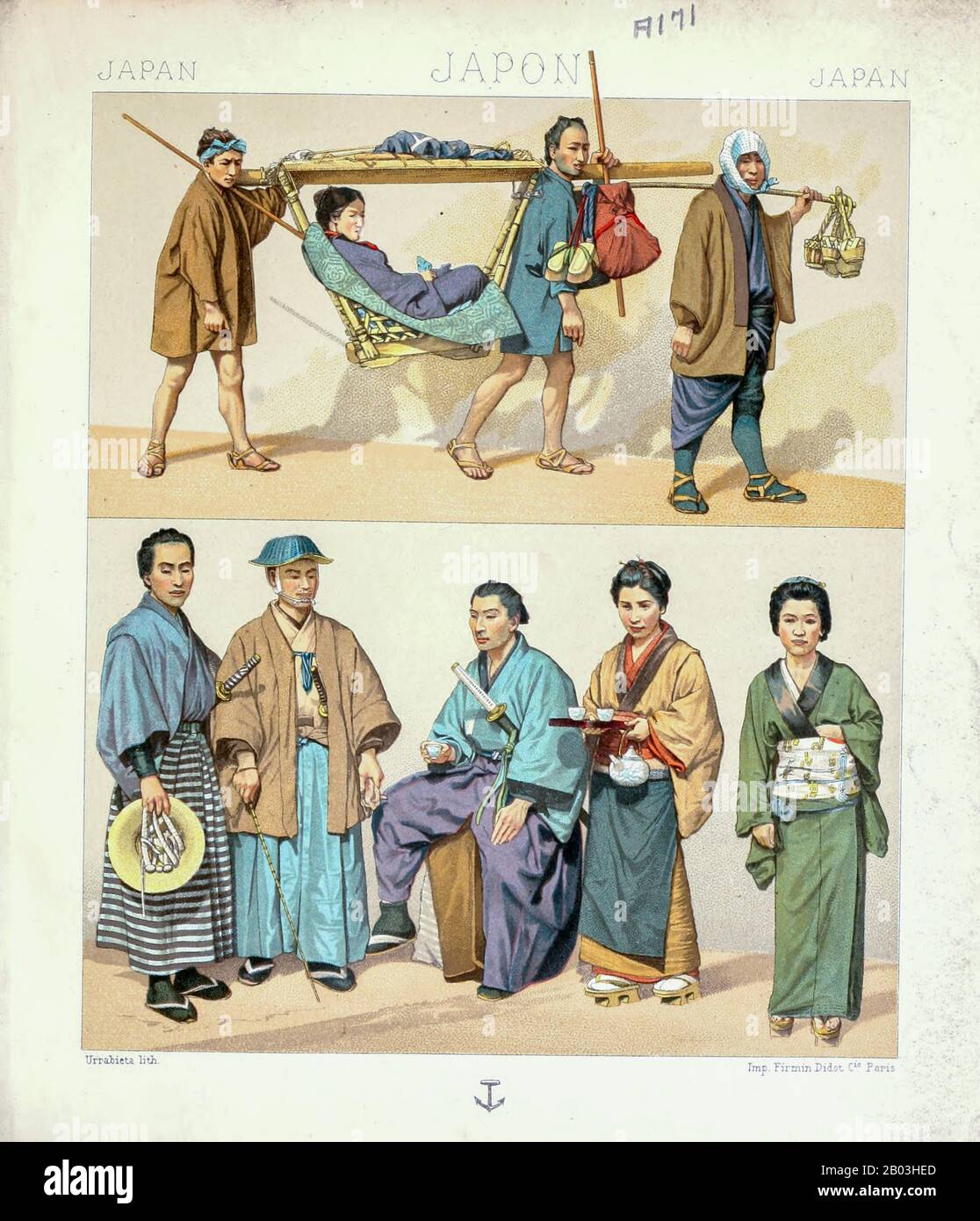
Ancient Japanese weapons
Ancient Japan had various special weapons. Therefore, the samurai, ninja, warrior monks and so on would use them. The Katana are the famous Japanese Blades. However, there were also other kinds of blades. These were the Tekkan and the Hachiwari. Gunsen, Tessen, and Gunbai were fans of war. The sickle was called the Kama. Moreover, there were Kiseru Battle Pipes too for blowing up the enemies. Some of these weapons find their use even today in different Japanese tribes. However, the interesting fact is almost no other nation used weapons like these in ancient times.
![]()




